
News and Analysis regarding scarce coins, markets, and the coin collecting community #339
A Weekly CoinWeek Column by Greg Reynolds ………
As already reported, “Lily Nicole” dimes and multiple Gene Gardner Coins have re-appeared in the auction at the Houston Money Show last December, shortly after the last Gardner sale in October. Additional Gardner coins re-emerged at the Central States show in April. Now, at least 20 are re-appearing in the official auction of the Summer FUN Convention this week in Orlando. Before addressing Gardner coins, there is discussion of the scope of this auction and some less expensive offerings of popular coins.
There are more than 1,500 coins in the Summer FUN sale. Coins that were in recent auctions may constitute a minor percentage of the entire offering.
Noteworthy FUN Auction
The Summer FUN Convention, at the Orange County Convention Center, is open to the public from Thursday to Saturday. More than 140 dealers will offer coins for sale. The floor sessions of the official auction by Heritage will be held on Thursday and Friday. An Internet-only session will close on Sunday at 4:00 PM Eastern Time (3:00 CT).
Recent Summer FUN auctions have been known for U.S. coins that are denominated below 50 cents, especially one-cent, five-cent and 10-cent coins. This year’s event is not an exception. For example, there are more than 60 uncirculated or Proof Buffalo nickels in the sale, including many representatives of relatively scarce dates.
The “SLADgrubb Collection” of early Lincoln cents is newsworthy. This collection features quite a few pre-1934 Lincolns that are designated by PCGS as having ‘full original mint red’ (“RD”). It is always a good idea to consult an expert before bidding. ‘Better dates’ that are PCGS-graded MS-66 or MS-67 with a ‘RD’ designation tend to cost multiples of the prices of the same respective dates in lower grades and may not always be good values. In some cases, red color on copper is unnatural, hence consult an expert.
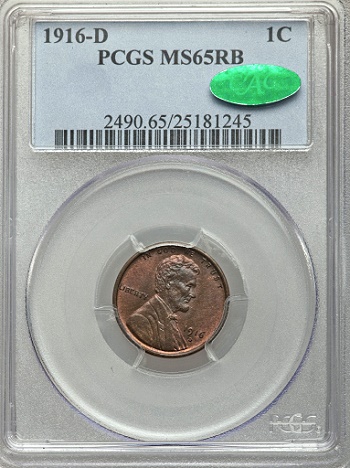 The “SLADgrubb” 1916-D penny is PCGS-certified as ‘MS-65 Red & Brown,’ and has a sticker of approval from CAC. From a logical perspective, this may turn out to be a good value. A 1916-D Lincoln with an apparently superior certification would be likely to cost thousands, while this coin has a market value between US$500 and $1,000.
The “SLADgrubb” 1916-D penny is PCGS-certified as ‘MS-65 Red & Brown,’ and has a sticker of approval from CAC. From a logical perspective, this may turn out to be a good value. A 1916-D Lincoln with an apparently superior certification would be likely to cost thousands, while this coin has a market value between US$500 and $1,000.
The “SLADgrubb” 1920-S cent likewise may be a good value. This 1920-S is PCGS-certified as ‘MS-64 Red & Brown,’ and has a sticker of approval from CAC. It seems to be mostly red in color. If it had been designated as “RD” rather than “RB,” it would probably sell for more than twice as much. Furthermore, a 1920-S that is PCGS-certified as ‘MS-65 RD’ would almost certainly sell for more.
There are than 150 other PCGS or NGC-certified Lincoln cents, including ten 1909-S VDB coins and five 1914-D cents. There are more than 80 certified Indian pennies in this auction, including five 1877 cents, the key date.
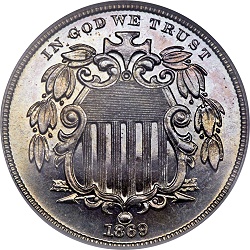 The “Black Bay Collection” of Proof Shield nickels includes multiple coins that are NGC-graded as 67 or higher, most with a ‘Cameo’ designation. The “Corso Collection” of Jefferson nickels includes many highly-certified Proofs. A few of those date from the late 1930s and early ’40s, are PCGS-graded 67 or higher, and are CAC-approved.
The “Black Bay Collection” of Proof Shield nickels includes multiple coins that are NGC-graded as 67 or higher, most with a ‘Cameo’ designation. The “Corso Collection” of Jefferson nickels includes many highly-certified Proofs. A few of those date from the late 1930s and early ’40s, are PCGS-graded 67 or higher, and are CAC-approved.
In most major or semi-major coin auctions, there are far too many coins and collections consigned to discuss or even mention in passing in a preview. Anyone who is interested may access listings by visiting the web sites of the respective auction firms. Also, auction catalogues in PDF format are often available to be downloaded for free.
Gene Gardner
Why is it important that Gene Gardner coins have been re-appearing? For the most part, the meaning and epic nature of the Gardner Collection is not widely understood or appreciated.
Gene built, by far, the all-time greatest collection of Liberty Seated coins overall, with the most amazing imaginable set of Liberty Seated quarters. He also assembled the all-time greatest set of Barber quarters. My research last year suggests that Gene had the third all-time-best set of business strike Barber half dollars.
Gardner’s sets of bust silver coins and Three Cent Silvers were extraordinary as well. Indeed, I cannot recollect a better set of Three Cent Silvers. Moreover, Gene had sets, including many superb pieces, of U.S. coin series that began early in the 20th century. Because his collection contained very few gold coins, Gene’s collection is not in the same league as the Brand, Newcomer, Col. Green, Norweb and Eliasberg Collections. In several areas, however, the Gardner Collection was superior to all those.
The first Gardner sale occurred around two weeks after the selling of the Pogue Family Collection was announced. Some feel the Gardner sales were overshadowed by the Pogue phenomenon from the outset, despite the fact that there was not a great deal of overlap.
Gardner and the Pogues had markedly different tastes, objectives, and priorities. While the Pogues had one of the all-time greatest groups of pre-1840 U.S. gold coins, Gardner did not have any of these, as far as I know. Although Gardner had some gem pre-1840 silver coins, including incredible 1796 and 1822 dimes, pre-1837 coins overall were of secondary importance to him. All of the Pogue coins auctioned so far are dated before 1840 and gem bust coins were among the top priorities for the Pogues.
The four Gene Gardner Coins auctions were in June 2014, October 2014, May 2015 and October 2015. It is curious that Gardner collection coins continue to highlight auctions. I am almost certain that Gene Gardner did not retain or ‘buy back’ any of the coins that he consigned.
So, many of the same coins that sold in 2014 or 2015 were consigned by others to auctions in December 2015 and 2016, presumably by buyers in the four sales of the collection. It is plausible, though, that some or all of these traded among wholesalers before being consigned again.
Gardner coins are not the only coins that re-appear at auction in relatively short time periods. There are even more re-appearing coins that are not specifically identified in catalogues as having been in a recent sale, especially coins that have been ‘upgraded.’
There are also two “Lily Nicole” pedigreed dimes in this Summer FUN sale. Each is PCGS-graded as “MS-67,” an 1897 and a 1906-S. The Lily Nicole set of dimes was auctioned in April 2015 by Heritage. Some re-appeared in a Stack’s-Bowers sale later last year, as I reported.
Gene Gardner Coins – Dimes
One of two 1869-S dimes that were in the Gardner Collection was NGC-graded as MS-65 and CAC-approved. On October 28, 2015, it sold for $4,465 in the Gardner IV event. Earlier, in the FUN auction of January 2007, this same coin realized $4,312.50. In both those sales, it was in the same early NGC holder, with a relatively plain, mostly white label on the front and without a hologram on the back of the holder.
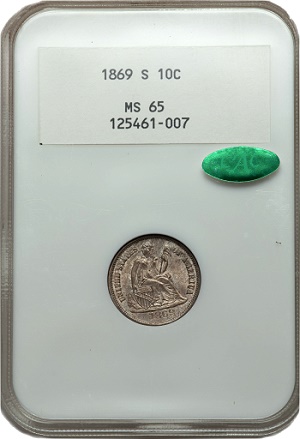 Since October, it has been upgraded by NGC to “MS-66+,” and no longer has a sticker of approval from CAC. Although grade-inflation is a terrible problem, the upgrading of this coin is not part of the problem. In terms of current standards, the earlier grade assignment of MS-65 was too low.
Since October, it has been upgraded by NGC to “MS-66+,” and no longer has a sticker of approval from CAC. Although grade-inflation is a terrible problem, the upgrading of this coin is not part of the problem. In terms of current standards, the earlier grade assignment of MS-65 was too low.
Not only does this 1869-S have the eye appeal of a MS-66 grade coin, this dime does, or did in 2015, score very high in the category of originality. The mellow russet toning and underlying original luster were impressive.
The Eliasberg 1872-S dime was in the Gardner Collection. The MS-65 grade assignment by PCGS probably occurred in 1996 or early 1997, not long after the Eliasberg ’96 sale. At the time, this grade was thought to be a little generous. Due to grade-inflation and evolving criteria, the MS-65 certification is no longer controversial and probably is widely accepted by interested experts. Indeed, this coin was approved by CAC in 2014.
In auctions in 2001, in 2015 and now in 2016, the PCGS holder apparently has the exact same green label with the Eliasberg name explicitly cited. At the Eliasberg ’96 auction by Bowers & Merena, before this coin was ever submitted to PCGS, it sold for $7,700. In October 2001, Heritage auctioned this Eliasberg 1872-S for $8,912.50.
At the Gardner III sale in May 2015, it went for $28,200. This week, the reserve is such that a commitment to pay $25,850 or more will be required to buy it.
The 1873 ‘With Arrows’ business strike in Gardner IV is PCGS-graded as ‘MS-65.’ In October 2015, it sold for $2,702.50. It now seems to be in the same PCGS holder; perhaps it was encapsulated in 2012.
In January 2007, in Orlando, Heritage auctioned this same coin, in a different holder, though with the same serial number. It then had a faded blue PCGS label from the early 2000s, which indicated that this 1873 dime was “Coin: 77” of “Series: 29.” In January 2007, this 1873 dime sold for $3,737.50. Market levels for Liberty Seated coins were much higher in January 2007 than they were in October 2015.
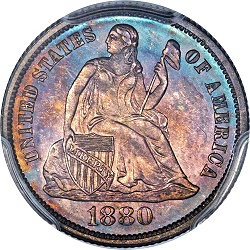 There is also a Proof 1873 ‘With Arrows’ dime in this sale with a Gardner pedigree. Although it continues to be NGC-certified as ‘Proof-67*,’ it was placed in a different NGC holder before April 2016. It did not sell in this year’s Central States auction. Earlier, on May 12, 2015, it brought $10,575. This week, it is being offered without a reserve. The current wholesale value estimate on Numismedia.com is $10,650.
There is also a Proof 1873 ‘With Arrows’ dime in this sale with a Gardner pedigree. Although it continues to be NGC-certified as ‘Proof-67*,’ it was placed in a different NGC holder before April 2016. It did not sell in this year’s Central States auction. Earlier, on May 12, 2015, it brought $10,575. This week, it is being offered without a reserve. The current wholesale value estimate on Numismedia.com is $10,650.
A Gardner Collection, PCGS-certified “Proof-67” 1880 dime realized $2585 in October 2015. Apparently, its current holder contains the same blue label that it had in 2015.The ‘Proof-67’ certification has been CAC-approved.
Gardner Quarters
On May 12, 2015, Gene’s 1805 quarter realized $70,500. It was in an old blue label holder, which probably dates from 2001 or 2002. It was PCGS-graded MS-64 and CAC-approved. It has since been upgraded at PCGS to “64+.”
Experts at CAC ignore the plus aspects of plus grades assigned at PCGS or NGC. So, a coin that is CAC-approved at the MS-64 level will be extremely likely to be CAC-approved again, if it is upgraded to “MS-64+,” assuming that the respective coin was not modified between submissions.
This 1805 quarter is not easy to grade because it has fabulous natural toning and has several very softly struck design elements, with perhaps a little friction. It has the eye appeal of a grade above 64 and surfaces that correspond to a grade below 64. Most experts are accepting of the assigned 64 grade.
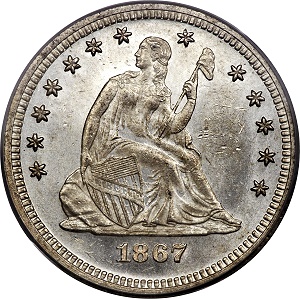 The color is captivating. Orange and red hues spotlight and outline the bust of Miss Liberty. There are tan textures in the inner fields, which contrast well with the blue and green tones in the obverse outer fields.
The color is captivating. Orange and red hues spotlight and outline the bust of Miss Liberty. There are tan textures in the inner fields, which contrast well with the blue and green tones in the obverse outer fields.
The Gardner 1843 business strike quarter re-appears in this sale. It is PCGS-graded as “MS-65” and does not have a CAC sticker.
Gene had three Proof 1862 quarters and one re-appears this week. It is PCGS-graded as “66.” In May 2015, it sold for $6,462.50.
Gene had six business strike 1867 quarters. The one that will be offered again this week is PCGS-graded MS-63 and CAC-approved. It might qualify for a higher grade if it did not have so many substantial contact marks and scratches in the obverse inner fields. In October 2015, this 1867 went for $3,760.
Gene had four Proof 1878 quarters. The one in this sale was NGC-graded as 66 in the past and was upgraded to “66+” at some point since October. As the old holder was badly scratched, this coin did need a new holder. This same coin realized $2,530 in July 2005 and $2,115 in October 2015.
Gardner Half Dollars
Gene had three 1847-O halves. The one that is re-appearing is of a re-punched mintmark variety, a characteristic that is very subtle in this instance. Nevertheless, the Gardner “1847-O/O” is a very desirable coin.
In October 2015, it was PCGS-graded as MS-64, CAC-approved, and in a PCGS holder from the 1980s! Since October, it has been upgraded to “64+,” a mistake. Coins in holders before 1995 tend to be worth significant premiums and PCGS holders from the ’80s are strongly demanded collectibles regardless of the coins inside. Certainly, many, though not nearly all, coins that were PCGS-graded in the 1980s would qualify for higher grades in the present.
This same 1847-O was auctioned for $8,625 in August 2006. In the Gardner IV sale, it realized $6,462.50, which was weak. Market values, though, have fallen a little bit more since last October.
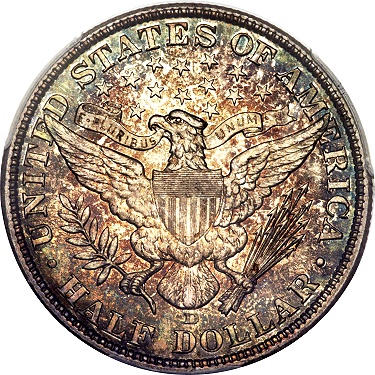 The Gardner 1907-D is PCGS-graded MS-66 and does not have a CAC sticker. The natural toning is mellow and pleasing. There are, though, significant gashes in Miss Liberty’s cap. Some grade this coin as 65 or 65+.
The Gardner 1907-D is PCGS-graded MS-66 and does not have a CAC sticker. The natural toning is mellow and pleasing. There are, though, significant gashes in Miss Liberty’s cap. Some grade this coin as 65 or 65+.
In May 2005, Heritage auctioned this same coin for $2,090. In October 2015, it realized $3,055, apparently a weak price for a “MS-66” grade 1907-D, but really a retail price for a MS-65+ grade 1907-D. Then and now, a wholesale price for a MS-66 grade 1907-D would be at least $3,250. For a MS-66 grade 1907-D half, the Numismedia.com wholesale value estimate is now $4,050 and the NGC price guide value is $6,000! In this case, it is hard to place a value on the holder.
The Gardner 1912-D is PCGS-graded MS-66 and CAC-approved. It has been PCGS-graded as MS-66 for more than 14 years. In January 2005, this same coin sold for $3,823.75, although it was overshadowed by the superior Hugon 1912-D that was auctioned the same week at the FUN Convention in Fort Lauderdale.
On January 4, 2012, this same coin brought $4,025, though it did not yet have a CAC sticker. At the Gardner IV sale in October 2015, it realized $3,760.
It is almost certainly among the 10 finest of the date. Though not the most attractive MS-66 grade Barber half in existence, this coin is almost flawless from a technical standpoint. It has the eye appeal of a 65 grade coin and the technical score of a 67 or higher grade coin. An overall grade of MS-66 is probably, widely accepted.
Only one 1912-D half has been certified as grading MS-67, and it has not been CAC-approved. Data published by PCGS, NGC and CAC regarding the number of MS-66 1912-D halves include multiple submissions of some of the same coins. MS-66 grade 1912-D halves may be rarer than they seem to be.
The 1797 15 stars half dime is probably rare in all grades. Certainly, this variety is extremely scarce. The Eliasberg-Gardner piece is one of the best. In May 1996, this same coin sold for $59,400. At the Gardner I sale on June 23, 2014, it brought $70,500. It was then PCGS-graded MS-64 and is now PCGS-graded as “MS-64+.” It has a CAC sticker.
This half dime is more attractive in actuality than it appears to be in published images. It really is a pleasing coin. Indisputably, it is among the five finest known, 1797, 15 stars obverse, half dimes.
It will be interesting to follow the lives of Gardner coins in the future. Maybe someday, the incredible nature of his collection will become widely understood.
©2016 Greg Reynolds




